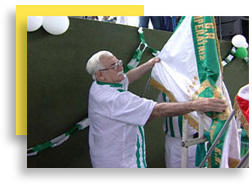
|
|
|
Empress of Carnival was produced and directed by the Brazilian filmmaker Medeiros Schultz. He studied film in the United States and it was there that he had the idea of making a feature documentary about a samba-school’s preparation for the “greatest show on Earth,” the carnival parade in Rio de Janeiro, Brazil. In reality, the original idea was to write a narrative script using the carnival parade as a backdrop. Since he had little knowledge about carnival, Schultz decided to research the matter on the Internet. He found little material there, but it was enough to fascinate him. He decided then to make a feature documentary about the samba-schools and their spectacular parade. |
 |
 |
It was late 1998 and in a few months the samba-schools would begin preparing for the 2000 parade. It was expected to be the best parade ever, because of the celebrations for the 500th anniversary of Brazil’s discovery. Schultz flew down to Brazil and met with Felipe Ferreira, author of “Rio’s Carnival Guide” (the two had hooked up through the Internet). From December of 1998 until February of 1999, Felipe introduced Schultz to the fourteen samba-schools that compete in the main carnival parade. In late February, Schultz went to the Sambadrome and witnessed, live for the first time, the carnival parade. Inspired by what he saw, he was more determined than ever to realize his project. |
| A project that would focus its attention on the Imperatriz Leopoldinense samba-school, for many reasons. First - the director explains - because Imperatriz had Rosa Magalhães, one of Rio’s most talented artistic directors, whose work in designing costumes and floats would certainly be interesting to film. Second, because Imperatriz was relatively unknown. “I wanted to show carnival in a new way, so it was appropriate to document the least known of all the major samba-schools,” Schultz concludes. There were also practical reasons for choosing Imperatriz. The school was very competitive and would most likely be selected to parade again on the Saturday after carnival. In that case, the filmmaker would have a second chance to film the school parading. Furthermore, the Imperatriz rehearsal space was well lit for filming, and the school management agreed to cooperate with the documentary production. |
|
 |
With everything planned, Medeiros Schultz returned to the US and convinced Roberto Kasinsky, a Brazilian businessman living in Miami, to fund the project. On May 30, 1999, Schultz was back in Rio and two days later he caught on tape the very first event in a samba-school’s preparation calendar: the announcement of the parade theme to the school’s samba composers. From then on, until the parade itself, on March 06, 2000, Schultz documented Imperatriz in all of its preparation work: the samba composition and competition, the artistic director's creative process, the production of the floats at the warehouse, the making of the costumes, the rehearsals, the school members at home and at work, and, of course, the school’s victorious 2000 parade. In all, 50 hours of material were recorded, including a groundbreaking surround-sound recording of the school’s renown percussion ensemble. |
|
Empress of Carnival is narrated, in Portuguese, by the journalist and author Sérgio Cabral. The English narration is done by Alex Teixeira. The documentary premiered in Rio, on February 17, 2001, at the famous Odeon-BR Theater. Among the guests were members of the Imperatriz Leopoldinense samba-school. Three days later, Empress of Carnival made its US premier at the Egyptian Theater, in Los Angeles. It was chosen by the Brazilian Ministry of Culture to close a three-day showcase of Brazilian Cinema. An audience favorite, Empress of Carnival has since been transferred from digital video - the original format - to 35mm film. It has participated in several prestigious film festivals in Brazil and abroad, winning the Best Documentary award at the XXVIII Jornada de Cinema da Bahia. For current news and acquisition information, visit the News page on this website. |
|